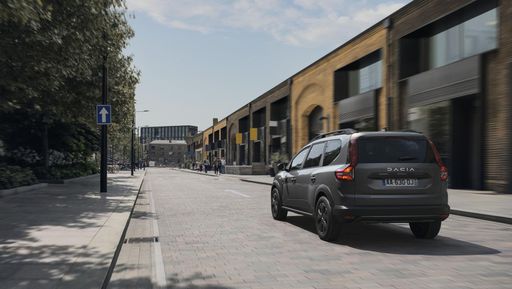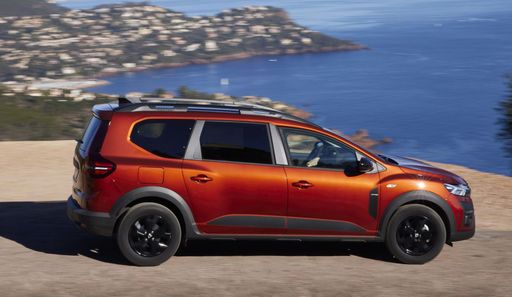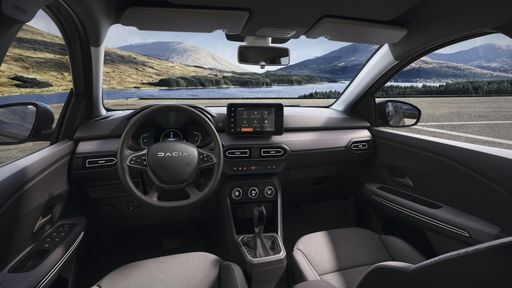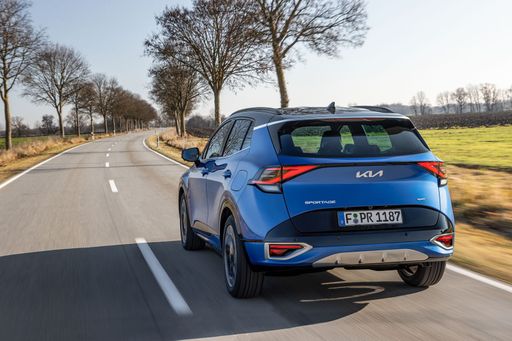In the ever-evolving world of automotive design and engineering, the Dacia Jogger and Kia Sportage stand out as commendable options for buyers seeking practicality, performance, and economy. This article breaks down their key features and innovations to help you make an informed choice.
Dacia Jogger vs Kia Sportage – Differences & prices compared
Two cars, one duel: Dacia Jogger meets Kia Sportage.
Which one wins in performance, efficiency and value for money? Find out now!
Body and Design: MPV vs. SUV
The Dacia Jogger, classified as a Multi-Purpose Vehicle (MPV), offers a unique blend of space and versatility. With a length of 4,547 mm and a height of 1,674 mm, it accommodates up to seven people, making it an ideal family vehicle. The interior boasts a trunk capacity of 607 liters, which can be extremely beneficial for those who need to transport larger items.
In contrast, the Kia Sportage takes the SUV route, boasting a more aggressive stance with a length of 4,515 mm and a width of 1,865 mm. Its sporty design is complemented by a luxurious interior that can hold 526 to 587 liters of cargo, depending on the variant. This SUV captures attention not just on the road, but also with its compelling design aesthetics.
Engine Performance: Power and Efficiency
The Dacia Jogger offers a range of engine options, including Full Hybrid, LPG, and petrol engines. The most powerful variant boasts 140 HP and can achieve 0-100 km/h in 9.8 seconds. Fuel efficiency is impressive as well, with consumption figures as low as 4.7 L/100 km, and CO2 emissions ranging from 105 to 137 g/km, making it a competitive option for environmentally conscious drivers.
On the other hand, the Kia Sportage presents a more powerful lineup with options reaching up to 252 HP. While achieving 0-100 km/h in only 8.3 seconds in its highest variant, it also offers various engine types, including petrol, diesel, and hybrids. The fuel consumption ranges from 5 to 7.2 L/100 km, and CO2 emissions vary between 132 to 162 g/km, reflecting its efforts to balance performance with efficiency.
Transmission Options: Manual vs. Automatic
The transmission systems of both vehicles are designed to enhance driving performance. The Dacia Jogger provides flexibility with both manual and automatic options, catering to diverse driver preferences. The automatic variants employ a smooth gear transition that complements the engine's capabilities.
Similarly, the Kia Sportage offers manual and automatic gearbox configurations, including a dual-clutch variant in some models. This technology allows for quicker shifts and enhances the driving experience, especially when navigating urban settings or tackling challenging terrains.
Technological Innovations: Features and Connectivity
Technological advancement plays a critical role in modern vehicles. The Dacia Jogger integrates essential features for convenience such as a user-friendly infotainment system and optional driver assist technologies that elevate the overall driving experience. Although budget-friendly, it does not compromise on safety and ergonomic design.
The Kia Sportage, a frontrunner in innovation, boasts a host of advanced technology features including a digital cockpit, comprehensive driver assistance systems, and enhanced connectivity options. With features like smartphone integration, advanced safety systems, and an intuitive layout, the Sportage appeals to tech-savvy consumers seeking a picturesque blend of luxury and utility.
Final Thoughts: Choosing Your Ideal Vehicle
Ultimately, both the Dacia Jogger and the Kia Sportage present strong cases for their respective markets. If you require a spacious, family-oriented vehicle with economical options, the Jogger promises reliability and efficiency at an attractive price point. In contrast, if you seek a sporty, technologically advanced SUV that doesn’t shy away from power, the Sportage should be at the forefront of your consideration.
Choosing between these two models boils down to personal preference and specific needs. Focus on what you value most in a vehicle—whether it's space and efficiency or performance and technology—and you'll find the ideal match for your driving lifestyle.
Here’s where it gets real: The technical differences in detail
Costs and Efficiency:
Price and efficiency are often the first things buyers look at. Here it becomes clear which model has the long-term edge – whether at the pump, the plug, or in purchase price.
Dacia Jogger has a clearly advantage in terms of price – it starts at 15400 £, while the Kia Sportage costs 30200 £. That’s a price difference of around 14742 £.
Fuel consumption also shows a difference: Dacia Jogger manages with 4.70 L and is therefore hardly perceptible more efficient than the Kia Sportage with 5 L. The difference is about 0.30 L per 100 km.
Engine and Performance:
Power, torque and acceleration are the classic benchmarks for car enthusiasts – and here, some clear differences start to show.
When it comes to engine power, the Kia Sportage has a clearly edge – offering 239 HP compared to 140 HP. That’s roughly 99 HP more horsepower.
In acceleration from 0 to 100 km/h, the Kia Sportage is clearly perceptible quicker – completing the sprint in 7.90 s, while the Dacia Jogger takes 9.80 s. That’s about 1.90 s faster.
In terms of top speed, the Kia Sportage performs to a small extent better – reaching 203 km/h, while the Dacia Jogger tops out at 174 km/h. The difference is around 29 km/h.
There’s also a difference in torque: Kia Sportage pulls noticeable stronger with 320 Nm compared to 200 Nm. That’s about 120 Nm difference.
Space and Everyday Use:
Whether family car or daily driver – which one offers more room, flexibility and comfort?
Seats: Dacia Jogger offers noticeable more seating capacity – 7 vs 5.
In curb weight, Dacia Jogger is distinct lighter – 1251 kg compared to 1552 kg. The difference is around 301 kg.
In terms of boot space, the Dacia Jogger offers slight more room – 607 L compared to 587 L. That’s a difference of about 20 L.
In maximum load capacity, the Dacia Jogger performs barely noticeable better – up to 1819 L, which is about 43 L more than the Kia Sportage.
When it comes to payload, Dacia Jogger minimal takes the win – 582 kg compared to 580 kg. That’s a difference of about 2 kg.
Who wins the race?
The Dacia Jogger proves to be slightly ahead and therefore becomes our DriveDuel Champion!
Dacia Jogger is the better all-rounder in this comparison.
 @ Dacia / Renault Group Media
@ Dacia / Renault Group Media
Dacia Jogger
Dacia Jogger
The Dacia Jogger is a no-nonsense family mover that stretches the idea of value with cavernous practicality and flexible space, perfect for buyers who need a sensible, everyday Swiss Army knife on wheels. It doesn’t try to be glamorous — instead it wins hearts with cheerful thrift, durable materials and honest engineering, giving you useful transport without the pretence.
details @ Dacia / Renault Group Media
@ Dacia / Renault Group Media
 @ Dacia / Renault Group Media
@ Dacia / Renault Group Media
 @ Dacia / Renault Group Media
@ Dacia / Renault Group Media
 @ Dacia / Renault Group Media
@ Dacia / Renault Group Media
Kia Sportage
The Kia Sportage proves you don't have to choose between style and sensible family motoring, wrapping modern, confident looks around a roomy, well-equipped cabin. It's an easy car to live with — comfortable on daily runs, pleasantly engaging when you want a bit of fun, and kind to your wallet so you can keep smiling at the fuel pump.
details @ Kia Corporation
@ Kia Corporation
 @ Kia Corporation
@ Kia Corporation
 @ Kia Corporation
@ Kia Corporation
 @ Kia Corporation
@ Kia Corporation
 @ Dacia / Renault Group Media
@ Dacia / Renault Group Media
|
 @ Kia Corporation
@ Kia Corporation
|
|
|
|
Costs and Consumption |
|
|---|---|
|
Price
15400 - 23400 £
|
Price
30200 - 43900 £
|
|
Consumption L/100km
4.7 - 7.8 L
|
Consumption L/100km
5 - 7.9 L
|
|
Consumption kWh/100km
-
|
Consumption kWh/100km
-
|
|
Electric Range
-
|
Electric Range
-
|
|
Battery Capacity
0.60 kWh
|
Battery Capacity
-
|
|
co2
105 - 137 g/km
|
co2
132 - 180 g/km
|
|
Fuel tank capacity
40 - 50 L
|
Fuel tank capacity
52 - 54 L
|
Dimensions and Body |
|
|---|---|
|
Body Type
MPV
|
Body Type
SUV
|
|
Seats
5 - 7
|
Seats
5
|
|
Doors
5
|
Doors
5
|
|
Curb weight
1251 - 1460 kg
|
Curb weight
1552 - 1733 kg
|
|
Trunk capacity
160 - 607 L
|
Trunk capacity
526 - 587 L
|
|
Length
4547 mm
|
Length
4540 mm
|
|
Width
1784 mm
|
Width
1865 mm
|
|
Height
1674 mm
|
Height
1645 mm
|
|
Max trunk capacity
1807 - 1819 L
|
Max trunk capacity
1715 - 1776 L
|
|
Payload
393 - 582 kg
|
Payload
543 - 580 kg
|
Engine and Performance |
|
|---|---|
|
Engine Type
Full Hybrid, LPG, Petrol
|
Engine Type
Petrol, Full Hybrid, Diesel MHEV
|
|
Transmission
Automatic, Manuel
|
Transmission
Manuel, Automatic
|
|
Transmission Detail
Automatic Gearbox, Manual Gearbox
|
Transmission Detail
Manual Gearbox, Dual-Clutch Automatic, Automatic Gearbox
|
|
Drive Type
Front-Wheel Drive
|
Drive Type
Front-Wheel Drive, All-Wheel Drive
|
|
Power HP
91 - 140 HP
|
Power HP
136 - 239 HP
|
|
Acceleration 0-100km/h
9.8 - 13.2 s
|
Acceleration 0-100km/h
7.9 - 11.6 s
|
|
Max Speed
167 - 174 km/h
|
Max Speed
180 - 203 km/h
|
|
Torque
160 - 200 Nm
|
Torque
250 - 320 Nm
|
|
Number of Cylinders
3 - 4
|
Number of Cylinders
4
|
|
Power kW
67 - 103 kW
|
Power kW
100 - 176 kW
|
|
Engine capacity
999 - 1598 cm3
|
Engine capacity
1598 cm3
|
General |
|
|---|---|
|
Model Year
2024 - 2025
|
Model Year
2025
|
|
CO2 Efficiency Class
C, D
|
CO2 Efficiency Class
F, D, E, G
|
|
Brand
Dacia
|
Brand
Kia
|
What drivetrain options does the Dacia Jogger have?
The Dacia Jogger is offered with Front-Wheel Drive.
The prices and data displayed are estimates based on German list prices and may vary by country. This information is not legally binding.
